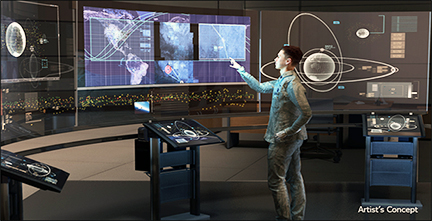

Ball Aerospace has been selected to continue work on the Space Evaluation and Analysis Capability (SEAC) testbed for the second phase of the Air Force Research Laboratory (AFRL) and Defense Advanced Research Projects Agency's (DARPA) Hallmark program.
The Hallmark program is advancing technologies that deliver real-time space-domain awareness informing the command and control and protection of space assets.

As part of the Hallmark program's second phase, Ball will collaborate with a set of independent software development teams and conduct three additional evaluation events in which the company will run mock space operations exercises to evaluate software tool performance. During the first phase of the Hallmark program, Ball completed five successful evaluations of the testbed.

Artistic rendition of the Hallmark program.
Image is courtesy of DARPA.
Under the Hallmark program, Ball is working to streamline this process, bringing essential mission capabilities into operations faster than ever before. Ball's approach to the SEAC testbed design eliminates the single-contractor integration bottleneck in traditional acquisition models. This modern software development practice succeeds by enabling external tool developers to rapidly design and test capabilities in an operations-like environment without risking system security or stability.
Executive Comment
Steve Smith, VP and GM, Systems Engineering Solutions, Ball Aerospace, said the company's revolutionary open architecture approach brings commercial capabilities and best practices like rapid integration of new services and secure DevOps to the Department of Defense. Ball Aerospace looks forward to continuing the successful demonstration of the firm's enterprise software architecture's capabilities during the second phase of the Hallmark program.
With 30 years of experience developing unique and accurate exploitation algorithms for satellite systems, Ball understands the challenges of integrating new features into operational systems.
About Hallmark

Dr. Fotis Barlos.
Dr. Fotis Barlos, the Program Manager for DARPA's Strategic Technology Office (STO), explained more about the Hallmark Program a the DARPA infosite...
Military commanders responsible for situational awareness and command and control of assets in space know all too well the challenge that comes from the vast size of the space domain. The volume of Earth’s operational space domain is hundreds of thousands times larger than the Earth’s oceans. It contains thousands of objects hurtling at up to 17,000 miles per hour. The scales and speeds in this extreme environment are difficult enough to grasp conceptually, let alone operationally, as is required for commanders overseeing the nation’s increasingly critical space assets. Complete and timely information is vital to a commander’s ability to react to events in space that may threaten critical and costly assets.
Current space domain awareness tools and technologies were developed when there were many fewer objects in space. Only a few nations could even place satellites in orbit, and those orbits were easily predictable without advanced software tools. That situation has changed dramatically in the past decade with a developing space industry flooding once lonely orbits with volleys of satellite constellations. Despite this much more complex and chaotic environment, commanders with responsibility for space domain awareness often rely on outdated tools and processes—and thus incomplete information—as they plan, assess, and execute U.S. military operations in space.
DARPA’s Hallmark program seeks to provide a full spectrum of breakthrough real-time space-domain systems and capabilities to help address these technical and strategic challenges. The envisioned system would fuse information from diverse sources, allow potential actions to be simulated and effects determined in advance, and vastly reduce the overall time required to make and execute decisions and observe results.
A state-of-the-art enterprise software architecture would support the ability to model current and future space situational awareness and command and control tools, capabilities, subsystems, and systems, as well as external interfaces to air, cyber, land, maritime , and command and control environments. An advanced testbed featuring playback and simulation capabilities would significantly facilitate research and development activities, experiments, and exercises to evaluate new technologies for their impact on space command and control capabilities. The testbed would be used to expedite the creation and assessment of a comprehensive set of new and improved tools and technologies that could be spun off into near-term operational use for the Defense Department’s Joint Space Operations Center (JSpOC) and Joint Interagency Combined Space Operations Center (JICSpOC).

